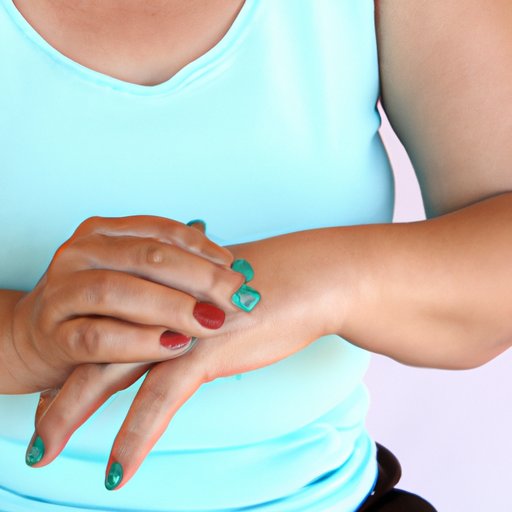Introduction
Summer is the season of fun in the sun, but with it comes the pressing issue of sunburn. Sunburn itch is a common and frustrating experience that can make the healing process uncomfortable and unbearable. In this article, we will delve into the science behind sunburn itch, effective home remedies for relieving it, and prevention tips that will make sunburn history.
The Science Behind Sunburn Itch: Understanding the Biology of Our Skin’s Response to UV Rays
Sunburn occurs when skin is exposed to ultraviolet (UV) rays, resulting in redness, tenderness, and blistering. The skin’s response to this UV radiation is to release melanin, a pigment that helps protect against further harm. However, when the skin cannot produce enough melanin, it becomes injured and inflamed.
More specifically, sunburn inflammation is caused by the body’s immune response to damaged cells. The skin’s natural response to injury is to send an army of white blood cells to repair the tissue. This causes the skin to become inflamed, resulting in the telltale redness, swelling, and pain. Additionally, sunburn itch is also caused by the inflammation response, which leads to the release of histamine, a chemical that triggers itching and swelling.
Soothing the Burn: Effective Home Remedies for Sunburn Itch
When you’re dealing with sunburn itch, finding relief can’t come quickly enough. Here are some effective home remedies for soothing the burn:
- Aloe vera: This natural anti-inflammatory agent cools and moisturizes the skin. Apply aloe vera gel to affected areas for quick relief.
- Apple cider vinegar: Its anti-inflammatory properties will help reduce swelling and itching. Mix equal parts water and apple cider vinegar and apply to sunburned skin with a compress or cotton ball.
- Colloidal oatmeal: Oatmeal baths or compresses can offer soothing relief for itching and inflammation. Simply mix colloidal oatmeal with cool water and apply to the affected areas as needed.
It’s important to note the safety considerations when using these remedies. Avoid using untested or unproven remedies, and always conduct a small test patch first to ensure there is no negative reaction to the product.

Breaking the Cycle of Sunburn Itch: How to Prevent Scratching and Promote Healing
When you’re dealing with sunburn itch, the first instinct is often to scratch the affected area. However, this only worsens the itching sensation and can cause further skin irritation, which can lead to blisters and scarring.
Instead, try to engage in other fun activities such as listening to music or watching a movie to divert your attention. Additionally, you can keep the affected area moist and hydrated, which will promote healing and reduce itching.
When Sunburn Goes Wrong: How Severe Cases of Itchiness Can Lead to Infections
Severe sunburn itch can lead to open wounds that can be prone to infection. Warning signs of an infection include warmth, redness, pain, or pus around the affected area. If you experience any of these symptoms, it is essential to seek medical treatment immediately to prevent the spread of infection.
The Psychological Effects of Sunburn Itch: How to Cope with the Discomfort and Pain
Sunburn itch can be mentally and emotionally taxing, leaving you feeling uncomfortable, frustrated, and helpless. It is essential to find ways to cope with these feelings while healing the affected area. One strategy is to practice deep breathing while focusing on a relaxing activity. Alternatively, you could talk to or seek support from family and friends for comfort.
From Aloe to Tea Tree Oil: Exploring the Best Products to Relieve Sunburn Itch
If home remedies aren’t relieving sunburn itch, there are plenty of commercial products available. Here are some of the most effective:
- Hydrocortisone cream: This cream is known for its anti-inflammatory properties and can offer quick relief for sunburn itch. Simply apply to the affected area twice daily.
- Cooling sprays: Cooling sprays containing natural extracts like peppermint, lavender, and tea tree oil can offer quick relief, comfort, and hydration for the skin.
- Antihistamines: Antihistamines can help relieve itchiness and reduce inflammation by blocking histamine release. They come in the form of tablets or creams that can be applied to the affected area.
It’s important to use these products only as directed and avoid using any products that cause an allergic reaction or skin irritation.
Staying Safe in the Sun: Tips for Avoiding the Itch and Other Dangers Associated with Sun Exposure
Preventing sunburn itch begins with avoiding sunburn altogether. Here are some tips for staying safe in the sun:
- Use sunscreen: Apply sunscreen with at least SPF 30 generously and often while you are out in the sun. Reapply every two hours or more frequently if you sweat or swim.
- Stay in the shade: Seek shade under umbrellas, trees, or other shelters. Remember that UV rays can penetrate through clouds and windows.
- Dress appropriately: Wear protective clothing like wide-brimmed hats, sunglasses, and long-sleeved shirts and pants to maximize protection against harmful rays.
Conclusion
Done correctly, sunburn itch can be alleviated at home with natural remedies or commercial products. The key to relief is prevention. Protecting skin from harmful UV rays can significantly reduce the risk of sunburn and its side effects. Take care of your skin, and seek medical attention when necessary. With the tips outlined in this article, you’ll be well on your way to a happy and healthy summer season.
